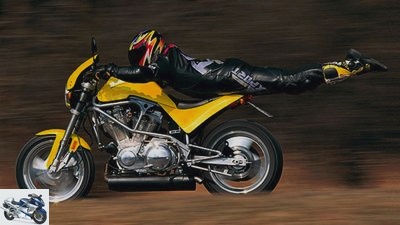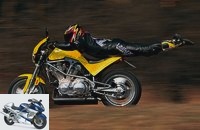Menus

duke
Final: Buell Lightning S1
Thunderstorm
You never would have thought that a Harley could turn into a sporty motorcycle. Erik Buell taught the world better. The Lightning S1 marked the dawn of a new era. Michael Pfeiffer on his first test drive.
For me, Harley-Davidson was the anachronism on two wheels in the mid-1990s: short of breath, quickly broken and quite vibrating piles of iron that were driven by pretty old men or heavily tattooed bikers in robes. A tour of the fair electrified me all the more "Motorcycles 1996" in Dortmund. There was a neon yellow naked bike on a rather small stand, so slim and sexy that my synapses oversteered. Can a Harley engine be in a sports suspension? Buell Harley-Davidson was emblazoned on the small tank, the two cylinders open 45 degrees, the bumper sleeves run parallel: it has to be a Sportster engine. The booth crew willingly provide information, the test drive is quickly arranged, I drive the first really fast Harley in Germany.
Buy complete article

Final: Buell Lightning S1
Thunderstorm
Buell turned the motorcycle world on its head with the Lightning S1. At least a bit. Around the sweeping Sportster V2, he braided a filigree tubular space frame with an extremely short wheelbase, an abundant steep steering head angle and a fairly short caster. He banned the strut and exhaust under the engine, inserted a modern White Power fork in the front and flanged a powerful six-piston brake caliper to the dip tube. Only one, but a huge brake disc is allowed to slow down at the front. This makes the Lightning look incredibly reduced and slim. For me it is still the most beautiful Buell that has ever been built. Almost Italian style.
But there was one problem: What on earth is that huge bread bin on the left? The Buell has to suck up too. And so that it can do this for a long time, it needs an air filter, like all engines. And this should flow through as freely as possible. A Helmholtz resonator is in there, the Harley-Davidson press department later informed. Aha. So a kind of resonance charge. If it helps…
duke
Completely untypical: Wheelie with Harley. Not difficult on the Buell, at least at the beginning…
It helps, a lot. The Buell shakes its power from the cylinders almost softly. Get started at under 2000 / min to really fire at 5000 / min. Fire? Yes, you read that right. This engine has bite, temperament, taste, tinder. And turns up to almost 7000 rpm – a speed at which Harleys normally already hoist the white flag. No, this Buell puts an end to the old prejudices. And despite the flywheel mass being four kilograms lighter than in the original Sportster, the Buell-V2 still runs smoothly and smoothly enough. Why doesn’t Harley do it himself? I don’t know, it wasn’t until a decade later that a similarly powerful engine from the main factory appeared with the XR 1200. The V2 presses around 90 hp, a respectable value for a two-valve engine. And it brings the performance inimitably full on the road. Booms deeply when rolling, rages angrily when accelerating. But never gets really pushy. Yeah, doesn’t even vibrate heavily. And makes short work of the barely 210 kilograms live weight plus driver. This is where you push, and if you have to, the front wheel lifts off. My first wheelie on a Harley, here I come! Usually, Harley front wheels are pressed against the ground, causing the tire to sweat. Now I’m sweating, because first my front wheel has to go down again. It almost happened – the first Harley backflip…
Short, very short, the Lightning’s wheelbase was too short. Under four feet is quite unusual. This leads to an equally unusual driving behavior in curves. Somehow the Buell doesn’t want to whet the corners neutrally. You really have to be forced into deep slopes. Has Master Erik tried it himself? Maybe, but I don’t think so. Because you can’t burn around the corner quickly like this. And Erik was a racing driver. He should know how a machine has to drive.
duke
The Lightning S1 likes best from the back. Think away from the bread box.
At least at the back she can’t really feather either. The shock absorber loaded the wrong way round bounces strongly, despite the various adjustment options. And then there is the poisonous brake. Something is required. After a hundred kilometers it’s over. Driver flat, needs a break. Fills up a few liters, only a good five go in now. Economical, economical. The neon yellow almost dazzles in the sunlight, the polished engine covers delight everyone, as do the beautifully ribbed cylinders and heads of the Milwaukee V2. The Lightning looks best from diagonally behind. The asymmetrical handlebar trim is pleasing at the front.
One year later, in 1997, the Lightning was officially launched in Germany. And almost 10,000 marks cheaper than the first gray imports from ’96. Erik Buell quickly became known to us too. His later designs attracted even more attention: aluminum bridge frame with an integrated petrol tank, the oil reservoir in the swing arm. All of this contributed to Erik’s reputation as a brilliant designer. How things went was a different matter. Sure, character bikes, and very individual. That was well received in Europe. The puffy-looking 1125R, Buell’s last coup with a Rotax two-cylinder engine, is different. It was – ironically of fate – quite successful in the USA. She could not prevent the end of the brand. Buell’s last thunderstorm.
Technical data of the Buell
duke
Buell banished the strut and the muffler to the engine. The Helmholtz resonator air filter box certainly brings a lot, behind it is a 40 mm Keihin carburetor.
Engine:
Two-cylinder four-stroke 45-degree V engine, two valves per combustion chamber, controlled via bumpers and rocker arms, bore x stroke 88.9 x 98.5 millimeters, 1203 cm3, 67 kW (91 hp) at 5800 rpm, 115 Nm at 5200 rpm, 40 mm carburettor, electric starter, oil bath clutch, five-speed gearbox, toothed belt drive.
Landing gear:
Steel lattice frame, upside-down fork at the front, two-arm swing arm at the rear, horizontal, tensile-loaded spring strut, single-disc brake at the front with six-piston fixed caliper, rear two-piston fixed caliper, 340/230 mm, cast wheels, 120/70 ZR 17 and 170/60 ZR 17 tires.
Measurements and weight:
Wheelbase 1397 mm, caster 99 mm, seat height 750 mm, weight with a full tank of 209.5 kg, tank capacity 15 liters, top speed 219 km / h. Price 28,500 marks (gray import 1996)
Related articles
-
fact test Buell Lightning XB12S evolution theory Buell is now finally leaving the ecological niche of the harmless exotic. The active XB12S poaching …
-
Long-term test Buell Lightning XB12S (interim result)
Artificial long-term test Buell Lightning XB12S (interim balance) Buell machines are certainly not off the peg Mass-produced goods. The more interesting the …
-
Review Buell Harley S1 Lightning
Archive Test, Buell S1 Lightning Buell Harley S1 Lightning +++ FROM A CURRENT OCCASION: a historical Buell article +++ Because it is a Harley? Because they…
-
Top test Buell XB12S Lightning
Gargolov Top-Test Buell XB12S Lightning The Pit-Buell A Pit Bull and an XB12S have a lot in common. Also that they are basically lamb-pious …
-
Endurance test final balance Buell Lightning XB12S
Bilski endurance test final balance Buell Lightning XB12S Prima Donner This is how they are, the Buells: capricious like prima donnas. But the dull rumble of the XB12S …
-
Comparison test two-cylinder: BMW R 1200 R, Buell Lightning XB12Ss and Moto Guzzi Griso 8V
fact comparison test two-cylinder: BMW R 1200 R, Buell Lightning XB12Ss and Moto Guzzi Griso 8V Big Twins only 1170, 1202, 1151 ?? these…
-
Driving report Buell Lightning Long XB12Ss
Driving report Buell Lightning Long XB12Ss Short or long driving Buell is a pleasure ?? for people of guard size so far rather a short one. The…
-
Buell S1 Lightning Strike review
Review Buell S1 Lightning Strike Spoiled for choice The new Buell S1 Lightning Strike is available in eleven different color combinations. And because that’s just for …
-
fact Top-Test Buell XB9R Firebolt Rythm and Race Swap fringed jacket for knee slider ?? Erik Buell also gives real Harley freaks access …
-
Hartmann 12 pictures archive 1/12 Narrow engine, tight fitting cladding, raised silencer – this is how the 916 enables inclines to beyond the …